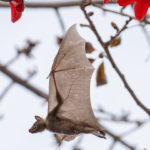Egyptian Fruit Bats Echolocate During the Day
Egyptian fruit bats are one of the 10 diurnal species among 1,400 bat species. Experts were surprised when they discovered that they use echolocation in broad daylight as other diurnal species rely rather on vision to avoid obstacles and forage during the day. The other species use echolocation when it’s dark or dim.
Egyptian fruit bats were echolocating by making clicking sounds. Researchers studied them more due to their surprise. They found that more than 70% of bats utilized echolocation regularly when they emerged from their colony. It was also found that they used clicking sounds more significantly when they approached scary obstacles in order to avoid crashing into them and used them less when they flew high above the ground. Despite Egyptian fruit bats’ good sight, they still echolocated when the light levels were the highest.
Learn about our two Decals!
 Click here to find out more about our Fall Bioinspired Design Decal and our Spring Bioinspired Design in Action Decal – ALL MAJORS are welcome.
Click here to find out more about our Fall Bioinspired Design Decal and our Spring Bioinspired Design in Action Decal – ALL MAJORS are welcome.Berkeley BioDesign Community
 Click here to learn about the BioD: Bio-Inspired Design @ Berkeley student organization or here to signup for more info.
Click here to learn about the BioD: Bio-Inspired Design @ Berkeley student organization or here to signup for more info.Search
Student Login




I imagine that the neurological circuits underlying these processes are governed by both 2d spacing maps with their brains as…
to reduce the impact of car accidents, it may be possible to study the force diverting physics of cockroaches to…
you see this type of head-bobbing stability in many avian creatures related to pigeons like chickens. the head ability to…
not like they taught horses how to run! this is an example of convergent evolution where both sea creatures and…
The brain functions in a similar way with neuronal connections. our brains are able to utilize the multiplicity of connections…